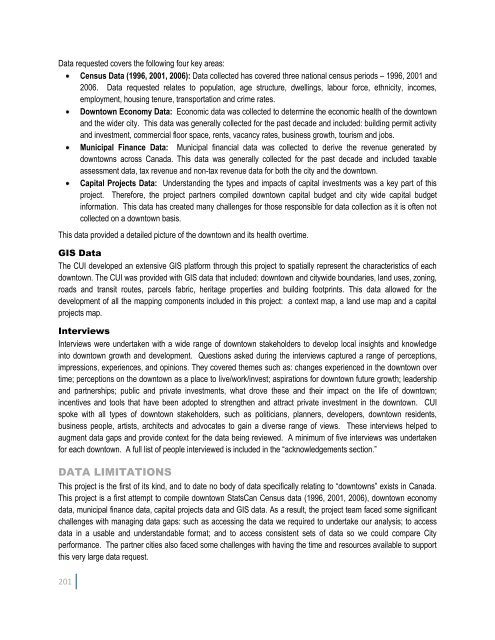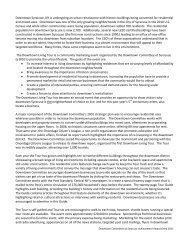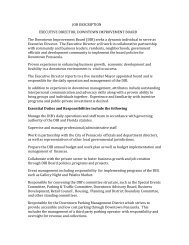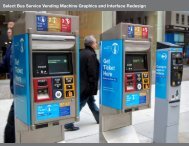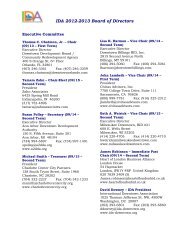The Value of Investing in Canadian Downtowns - International ...
The Value of Investing in Canadian Downtowns - International ...
The Value of Investing in Canadian Downtowns - International ...
You also want an ePaper? Increase the reach of your titles
YUMPU automatically turns print PDFs into web optimized ePapers that Google loves.
Data requested covers the follow<strong>in</strong>g four key areas:<br />
Census Data (1996, 2001, 2006): Data collected has covered three national census periods – 1996, 2001 and<br />
2006. Data requested relates to population, age structure, dwell<strong>in</strong>gs, labour force, ethnicity, <strong>in</strong>comes,<br />
employment, hous<strong>in</strong>g tenure, transportation and crime rates.<br />
Downtown Economy Data: Economic data was collected to determ<strong>in</strong>e the economic health <strong>of</strong> the downtown<br />
and the wider city. This data was generally collected for the past decade and <strong>in</strong>cluded: build<strong>in</strong>g permit activity<br />
and <strong>in</strong>vestment, commercial floor space, rents, vacancy rates, bus<strong>in</strong>ess growth, tourism and jobs.<br />
Municipal F<strong>in</strong>ance Data: Municipal f<strong>in</strong>ancial data was collected to derive the revenue generated by<br />
downtowns across Canada. This data was generally collected for the past decade and <strong>in</strong>cluded taxable<br />
assessment data, tax revenue and non-tax revenue data for both the city and the downtown.<br />
Capital Projects Data: Understand<strong>in</strong>g the types and impacts <strong>of</strong> capital <strong>in</strong>vestments was a key part <strong>of</strong> this<br />
project. <strong>The</strong>refore, the project partners compiled downtown capital budget and city wide capital budget<br />
<strong>in</strong>formation. This data has created many challenges for those responsible for data collection as it is <strong>of</strong>ten not<br />
collected on a downtown basis.<br />
This data provided a detailed picture <strong>of</strong> the downtown and its health overtime.<br />
GIS Data<br />
<strong>The</strong> CUI developed an extensive GIS platform through this project to spatially represent the characteristics <strong>of</strong> each<br />
downtown. <strong>The</strong> CUI was provided with GIS data that <strong>in</strong>cluded: downtown and citywide boundaries, land uses, zon<strong>in</strong>g,<br />
roads and transit routes, parcels fabric, heritage properties and build<strong>in</strong>g footpr<strong>in</strong>ts. This data allowed for the<br />
development <strong>of</strong> all the mapp<strong>in</strong>g components <strong>in</strong>cluded <strong>in</strong> this project: a context map, a land use map and a capital<br />
projects map.<br />
Interviews<br />
Interviews were undertaken with a wide range <strong>of</strong> downtown stakeholders to develop local <strong>in</strong>sights and knowledge<br />
<strong>in</strong>to downtown growth and development. Questions asked dur<strong>in</strong>g the <strong>in</strong>terviews captured a range <strong>of</strong> perceptions,<br />
impressions, experiences, and op<strong>in</strong>ions. <strong>The</strong>y covered themes such as: changes experienced <strong>in</strong> the downtown over<br />
time; perceptions on the downtown as a place to live/work/<strong>in</strong>vest; aspirations for downtown future growth; leadership<br />
and partnerships; public and private <strong>in</strong>vestments, what drove these and their impact on the life <strong>of</strong> downtown;<br />
<strong>in</strong>centives and tools that have been adopted to strengthen and attract private <strong>in</strong>vestment <strong>in</strong> the downtown. CUI<br />
spoke with all types <strong>of</strong> downtown stakeholders, such as politicians, planners, developers, downtown residents,<br />
bus<strong>in</strong>ess people, artists, architects and advocates to ga<strong>in</strong> a diverse range <strong>of</strong> views. <strong>The</strong>se <strong>in</strong>terviews helped to<br />
augment data gaps and provide context for the data be<strong>in</strong>g reviewed. A m<strong>in</strong>imum <strong>of</strong> five <strong>in</strong>terviews was undertaken<br />
for each downtown. A full list <strong>of</strong> people <strong>in</strong>terviewed is <strong>in</strong>cluded <strong>in</strong> the “acknowledgements section.”<br />
DATA LIMITATIONS<br />
This project is the first <strong>of</strong> its k<strong>in</strong>d, and to date no body <strong>of</strong> data specifically relat<strong>in</strong>g to “downtowns” exists <strong>in</strong> Canada.<br />
This project is a first attempt to compile downtown StatsCan Census data (1996, 2001, 2006), downtown economy<br />
data, municipal f<strong>in</strong>ance data, capital projects data and GIS data. As a result, the project team faced some significant<br />
challenges with manag<strong>in</strong>g data gaps: such as access<strong>in</strong>g the data we required to undertake our analysis; to access<br />
data <strong>in</strong> a usable and understandable format; and to access consistent sets <strong>of</strong> data so we could compare City<br />
performance. <strong>The</strong> partner cities also faced some challenges with hav<strong>in</strong>g the time and resources available to support<br />
this very large data request.<br />
201


